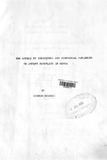| dc.description.abstract | In this study an attempt is made to examine the
effects of various factors on infant mortality in Kenya.
These factors are grouped into two general categories -
those associated with the individual woman/child and
those associated with the social and environmental setting
within which they live. The first set of variables
is identified as "individual variables" and includes
variables such as age of woman, education, sex of child,
etc. The second set of variables constitute. the "contextual
variables" and includes variables such as
availability of health facilities, water supply, sanitation
and prevalence of malaria.
The objective is to examine the combined effect
of all the factors on infant mortality, a deviation
from most studies which have only focused on individual
factors. The study employs two statistical models,
the ordinary Least Squares and the logistic regressions
in examining the relationships between these two sets
of variables and mortality.
The findings indicate that while most variables
included in the model were significantly related to
mortality, breast feeding and the number of pregnancies
to a woman in particular are major determinants of
mortality in the country.
Even more important, the findings show that the
effect of the contextual variables on infant mortality
is stronger at the regional level where for some regions
large percentages of population have poor access to such
facilities as health services, water supply and sanitation.
Thus infants born in such regions have lower
chances of survival given that their individual characteristics
already exposes them to higher mortality.
One important contextual variable is the high
prevalence of malaria in some regions. It has a strong
positive effect on mortality in those areas.
The findings point to the fact that efforts aimed
at reducing infant mortality in Kenya must focus, not
only on individual characteristics of the population,
but also with greater emphasis on the distribution of
essential facilities, water supply, health services,
as well as eradication of malaria. | en |

